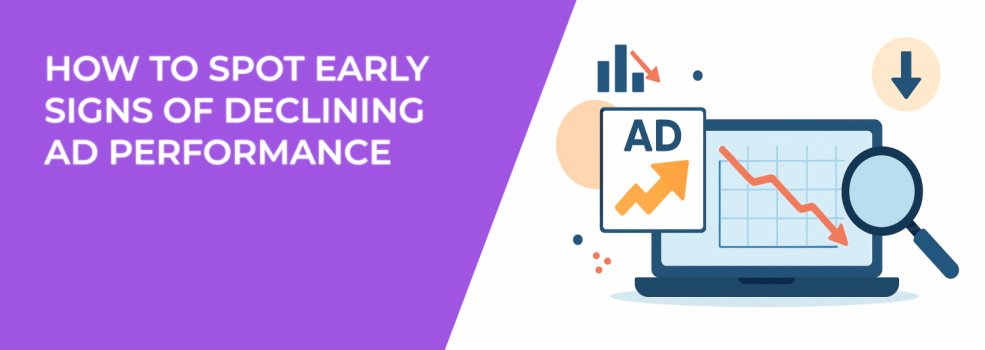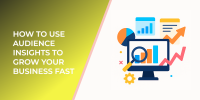When your ad campaigns start underperforming, the decline rarely happens overnight. Most of the time, the indicators appear gradually — a drop in engagement, higher costs, fewer conversions. But if you know what to watch for, you can intervene early and avoid wasting budget or losing revenue.
In this guide, you’ll learn how to track the right metrics, identify red flags early, and make strategic improvements to keep your Facebook and Instagram ads delivering consistent results.
1. Click-Through Rate (CTR) Begins to Decline
CTR is a key signal of how relevant and appealing your ad is to your audience. A healthy CTR means your creative is strong and your targeting is on point. But when CTR begins to fall — especially while impressions stay the same — it often signals that something is breaking down.
Why CTR declines:
-
Ad fatigue. Your audience has seen the same creative too many times, and it's no longer getting their attention.
-
Irrelevant targeting. Your message is being shown to users who aren’t aligned with your offer.
-
Weak creative hooks. If your ad fails to grab attention in the first few seconds, most users will scroll right past it.
Want help identifying what’s holding back your CTR? Learn how to fix low-performing creatives in this guide: Why Your Facebook Ads CTR Dropped and How to Fix It.
2. CPM Starts Rising Without a Clear Explanation
CPM — cost per 1,000 impressions — is heavily influenced by competition and ad relevance. It’s normal for CPM to rise during high-traffic periods like Q4. But if you’re seeing steady increases outside of seasonal trends, it's time to investigate.
Potential causes of a rising CPM:
-
Poor engagement rates reduce your relevance score, making your ads more expensive to deliver.
-
Saturation of your audience increases the cost of showing your ad to fresh eyes.
-
Your ad structure or targeting may be too broad, forcing Meta’s algorithm to work harder to find matches.
Not sure whether your audience is too broad or too specific? Use this resource to troubleshoot: Facebook Ads Audience Too Narrow? How to Troubleshoot a Limited Audience.
3. Frequency Gets Too High
When your ad frequency increases past a certain threshold — often around 3.5 or 4 — performance usually suffers. Users are exposed to the same message repeatedly and may become indifferent or even annoyed.
Here’s how to interpret the numbers:
-
1–2 frequency: Normal for cold traffic and broad campaigns
-
3–4 frequency: Caution zone. Start rotating creatives or segmenting audiences
-
5+ frequency: High risk of ad fatigue. Your campaign needs attention
If you’re unsure how frequency impacts scroll behavior, explore How Frequency Capping Helps Beat Facebook Ad Fatigue for practical techniques.
4. Engagement Drops While Spend Stays the Same
When engagement metrics like likes, comments, shares, and saves decline but your budget remains consistent, your audience is no longer responding.
This is often due to:
-
Repetitive or stale creative
-
Shifting user interests
-
Lack of variation in ad formats
Instead of just increasing spend to “force” better results, assess whether your content needs a strategic refresh. One helpful tactic is to use user-generated content or native-style creatives — formats that feel less like ads and more like organic posts.
Check out these insights on How to Use User-Generated Content in Your Facebook Ads.
5. ROAS and Cost Per Result Are Moving in the Wrong Direction
If your cost per result begins creeping upward while your ROAS drops, your campaign is heading toward inefficiency. Even if volume stays high, profitability can quickly erode.
Key things to evaluate:
-
Have landing page conversion rates dropped?
-
Has your average order value changed?
-
Are you tracking ROAS over the right attribution window?
-
Are creative and targeting still aligned with buyer intent?
Sometimes a high-performing campaign deteriorates because of internal misalignment — not just external competition. Knowing when to switch goals or update creatives is crucial.
This article will help you understand how to evaluate goals properly: Meta Ad Campaign Objectives Explained: How to Choose the Right One.
6. Your Audience Is No Longer Performing
Even with excellent creatives and solid structure, results will suffer if your audience quality declines. Over time, your core audiences — especially lookalikes or retargeting pools — can lose effectiveness.
This might show up as:
-
A drop in engagement or conversions from previously high-performing segments
-
Rising acquisition costs for once-affordable users
-
Decreased delivery due to audience overlap or small audience sizes
If you're struggling to find fresh, high-intent users, consider building new custom audiences from organic engagement or community activity.
LeadEnforce enables you to do exactly that — by building custom audiences from Facebook group members and Instagram page followers, you can target engaged users Meta doesn’t give you access to natively. Learn how in this breakdown: How to Build Your Target Audience from a Facebook Group.
7. Warnings Like “Ad Set May Get Zero” Begin to Appear
If you’ve seen alerts such as “Ad Set May Get Zero Conversions” in Ads Manager, it’s often a sign of a misconfigured audience, poor optimization settings, or a problem with campaign structure.
Don’t ignore these system warnings — they usually appear before actual performance drops.
This article explains what they mean and how to fix them: Why You See 'Ad Set May Get Zero' on Facebook and How to Fix It.
Final Thoughts
Your Facebook and Instagram campaigns don’t just stop working out of the blue. They send signals — small, measurable shifts — that let you know it’s time to adapt. The most successful advertisers are those who track performance regularly and act before problems become costly.

